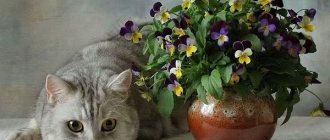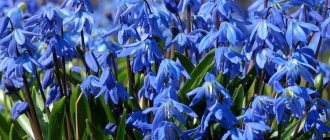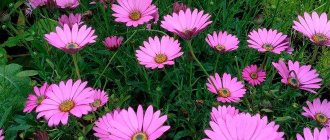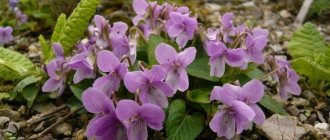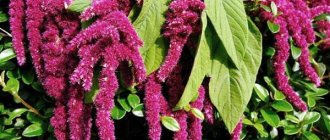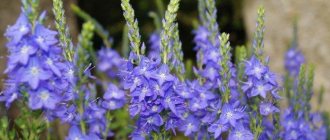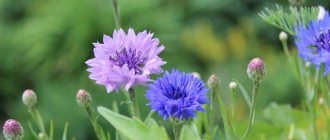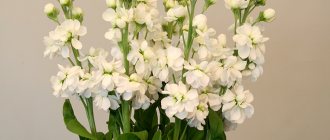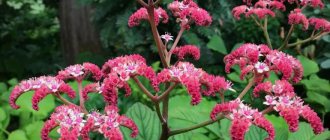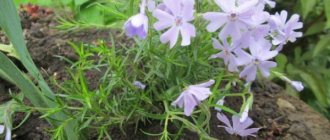From June until the onset of autumn, spectacular golden flowers, strongly reminiscent of miniature poppies, can be seen in the flower beds.
This is Californian eschscholzia, discovered more than two hundred years ago in the south of the North American continent and since then has become one of the favorite plants of flower growers all over the world. European settlers arriving in America believed that the new lands hid incredible treasures. One has only to dig and the depths will reveal the wealth hidden in them. This is apparently why flowers of a bright sunny hue are still called Copa de Oro or golden cup by Spanish-speaking Americans and Mexicans. The local population believes that where the eschscholzia opens its corollas, gold nuggets can eventually be found.
Of course, this is nothing more than a beautiful legend, but in a number of regions of the United States the flower is legally protected, and in California it has been considered a living symbol of the state for more than a century.
What does the plant look like? Are there any real benefits or harms from eschscholzia, and how to grow a flower on your own plot?
general characteristics
Eschscholzia is a very delicate and graceful flower. It not only looks like a poppy, but is actually a distant relative of it. This is a small branched bush with beautiful openwork leaves and shiny flowers.
Each eschsolzia flower lives only a few days, and only in sunny weather. But there are so many of them that even this is enough. On average, flowering lasts a very long time - from early summer to mid-autumn.
Not only flowers, but also leaves have excellent decorative qualities. They are covered with a bluish coating and slightly resemble wormwood. Dense thickets of Eschscholzia are spectacular even without companion flowers.
According to legend, the golden flowers of Eschscholzia have deceived gold miners for years. The plant has thin but very numerous shoots, and also has a delicate but long tap root. The sensitive buds close on cloudy, cold, windy and rainy days.
Photo: zen.yandex.ru
Eschsolzia in landscape design
Bright colors are actively used in landscape design. Volumetric bushes with openwork leaves have decorative value even before they bloom.
Eschscholzia is the best option for decorating a Moorish lawn. This is due to the possibility of its growth surrounded by grass and wildflowers.
Some varieties are distinguished by creeping shoots of small height, which will look good in a rock garden and in a flower bed. The appearance of the plant can be seen in the photo below.
Types of Eschsolzia
There are several dozen varieties of Eschscholzia, but several of them are cultivated in our latitudes!
Californian Eschscholzia
The most popular species in our latitudes, and it is this plant that is called California poppy. The varieties are taller and can grow up to 40 cm. The shoots are thin, but ribbed, and the flowers are single and cup-shaped, up to 9 cm.
Photo: 2sotki.ru
Soddy Eschscholzia
A miniature herbaceous variety rarely grows above 15 cm. The leaves are collected in graceful rosettes with numerous peduncles and yellow flowers up to 3 cm.
Photo: pixabay.com
apple blossom
One of the most popular varieties that attracts attention with large double flowers. It can also be recognized by its characteristic color, because the edges of the rich pink petals gradually lighten closer to the middle.
Photo: cvetokras.ru
Eschscholzia Mikado
Breeders bred this variety for lovers of delicate simple flowers. At the same time, they are quite large, up to 7 cm, and stand out with a bright orange center.
Photo: wallpaperscraft.ru
Fruity explosion
Another popular variety of Californian Eschscholzia, and again the unusual structure of folded petals. There are many pink and crimson flowers.
Photo: o-flora.com
Eschsolzia Ballerina
A variety with giant bright flowers. The diameter of the opened bud can reach 15 cm, which is not entirely typical for Eschscholzia. How can one resist such beauty?
Photo: kryuckom.ru
Ranunculus flowers (50 photos): types, planting and care
Description of the plant
Eschscholzia or California poppy is a genus of annual and perennial herbaceous plants from the Poppy family.
In its natural environment, it can be observed in large quantities in the southwestern arid regions of North America. This flower has been the official symbol of the state of California in the United States since the 20th century. This small plant owes its name to the Russian traveler, doctor, botanist and zoologist Johann Friedrich von Eschscholz, who lived at the turn of the 18th-19th centuries.
The Spaniards call the flower “golden cup” because of its bright yellow-orange petals. According to legend, where the poppy grows, the earth is full of gold, because when the flower petals fall into the ground, they turn into ingots of precious metal.
The flower received its unofficial, but one might say popular name, “wormwood”, due to the similarity of the bluish-gray, openwork leaves with the leaves of wormwood.
Herbaceous, low plant 20-50 cm in height, mostly annual, less often perennial. The stem is bare, gray-green, thin, ribbed, with numerous shoots. The leaf blades, deeply dissected three times with a waxy coating, are bluish-green, arranged in an alternate order on the stem. The basal leaves are collected in a rosette. The bushes are branched, compact, sometimes creeping.
The bush blooms profusely throughout the summer, from June until autumn, almost until October.
An interesting feature of the plant is that it is not every day that you can see blooming, bright flowers. Clear, sunny weather is the conditions under which Eschscholzia is ready to shine in all its glory. But as soon as it begins to get dark or the weather deteriorates, the flowers close. Flowers, single 2-7 cm in diameter, simple or double, without aroma. The shape of the flower resembles a bowl. The petals are glossy, whole, round, large, white, cream, pink, yellow, orange, red. The flowering period of a single flower is short, only 3-5 days. But thanks to the large number of buds on one bush, the impression of constant flowering is created. When one flower withers, another blooms.
For long flowering, faded flower stalks are removed. A month after flowering, the fruits ripen in the form of a pod-shaped, pointed seed pod with a large number of small, spherical brown or dark gray seeds. If they are not removed in time, the plant will quickly fill the nearest area by self-sowing. Moreover, self-seeding perfectly eliminates the need for annual planting.
To preserve the seed, the pods are cut off as soon as they begin to turn yellow.
The seed pods are stored in cardboard boxes or paper bags, where they ripen. If you store poppy seeds in a cool place, for example, in the refrigerator, their germination will remain for three years. The fresher the seeds, the richer the seedlings will be.
Eschscholzia care
There are only two main subtleties of caring for Eschscholzia - do not overuse watering and immediately choose a permanent place for planting. In addition, keep in mind that the plant grows very densely, so weeding the flowerbed will be problematic.
Temperature
Eschscholzia does not like frost, which is why it is planted as an annual in colder regions. But with proper care, it will tolerate short-term frosts down to -5 degrees. But high temperatures do not frighten her at all.
Photo: landscapeportal.ru
Lighting
Eschscholzia loves bright sunlight, so you can safely choose the most illuminated areas. She is not afraid even of direct sunlight in the hot summer.
Photo: vosadu-li-vogorode.ru
Watering
Too intense watering is the main cause of all Eschscholzia diseases. It needs to be watered more or less intensively only when the drought is completely prolonged and the soil is completely dry. Even in the hottest summer, you cannot flood the planting every day. Also choose for the procedure in the evening, when the buds have already closed.
Photo: 7dach.ru
The soil
Eschscholzia does not tolerate acidic soils and close groundwater. Before planting, be sure to loosen the area and then lightly mulch the small, light seeds. The plant thrives in dry, infertile soil, where other garden flowers do not take root.
Photo: liveinternet.ru
Fertilizers and fertilizing
Eschscholzia does not require additional care at all. Moreover, this can even harm her. Reduce planting fertilizers to a minimum, and in fertile soil it is better to do without fertilizing at all.
Photo: zen.yandex.ru
Trimming
Eschscholzia is a perennial and should be pruned closer to winter. Feel free to cut off the entire above-ground part of the plant to make it even more beautiful in the spring. And during flowering, it is important to promptly remove damaged stems, wilted buds and old faded shoots. This is necessary for Eschscholzia to grow further.
Photo: zen.yandex.ua
Heuchera (50 photos): types, planting and proper care
Medicinal properties of Californian eschscholzia
Flower growers are attracted by the simple planting and care of Eschscholzia in the open ground, its bright long-lasting flowering and many spectacular varieties. However, these are not all the advantages of the plant.
In landscape design, eschscholzia is used on alpine hills, in mixborders with other annuals, to form a Moorish lawn and in traditional flower beds.
A member of the Poppy family, Eschscholzia was traditionally used by American Indians as a pain reliever and sedative. Modern research into the medicinal properties of Californian Eschscholzia has fully confirmed folk experience.
All parts of the plant have biological activity. Raw materials containing alkaloids such as chelirubin, sanguinarine and macarine, flavone glycosides and other valuable substances are collected during flowering, dried or used fresh.
For medicinal purposes, Californian poppies are used to prepare extracts, alcoholic tinctures and powders that have a calming, analgesic and antispasmodic effect.
The most common indications for use are:
- insomnia;
- anxiety and nervous tension;
- toothache and spasmodic pain;
- urinary incontinence.
For the older age group, preparations from eschscholzia will be useful for the prevention of memory disorders and improvement of intellectual well-being in general.
Consuming California poppy tincture or powder may cause unwanted reactions in the body. Therefore, before taking it, you need to consult your doctor.
The juice of the plant has analgesic properties. To relieve pain from damaged or inflamed gums, fresh Californian eschscholzia root is cut lengthwise and applied to the affected area. Thanks to its antimicrobial properties, the product facilitates and speeds up treatment:
- abrasions;
- scratches;
- irritation;
- inflammatory processes on the skin and mucous membranes.
Antispasmodic qualities help relieve:
- muscle pain and spasms;
- nervous tension after a hard day;
- attack of hacking cough.
At high body temperatures, a decoction or infusion of eschsolzia will play the role of a natural antihistamine. A tincture from the root of the plant is used to treat the mammary glands to suppress lactation in women who are breastfeeding. And the powder is the basis of the folk method of getting rid of head lice.
Preparation and dosage of eschsolzia infusion
A water infusion can be prepared using 2 grams of dried herb and 150 ml of water. The plant material is poured with boiling water, brought to a boil and left to infuse. The finished composition is filtered and drunk 2-3 times a day at:
- insomnia;
- irritability;
- anxiety and other mild disorders.
If you have an extract or alcohol tincture of California poppy in your medicine cabinet:
- for mild pain and anxiety, drink 15 to 25 drops three times a day;
- in severe cases, the dose is increased to 30–40 drops and consumed 2–5 times a day.
Unlike poppy, which requires special care, the plant does not contain opiates.
Therefore, despite the mass of beneficial properties, Eschscholzia has significantly fewer contraindications.
Precautions when taking Eschscholzia californica
If you follow the recommendations of a specialist and the prescribed dosages, the plant is considered safe for children and adults. It can be grown without restrictions in the garden and at home.
The use of California poppy-based products is not recommended for women who are pregnant or breastfeeding.
Planting and propagation of eschsolzia
Due to the long but fragile root system, which actively grows deeper, Eschscholzia is not planted as seedlings. For propagation, seeds are used, which can be sown in early spring or mid-autumn. Most often, autumn sowing provides more abundant flowering, but then we recommend covering the seeds with a thick layer of leaves for the winter.
In the future, Eschscholzia reproduces well by self-sowing for at least the next few years. So if the shape of the decorative composition is important to you, you will have to thin it out regularly. By the way, the plant is also thinned out when planting so that the seedlings grow at a distance of about 20 cm.
Photo: vosadu-li-vogorode.ru
Secrets of seed growing and optimal timing
Eschscholzia reproduces exclusively by seeds. It can be sown both in the fall directly in open ground, and in the spring to obtain seedlings.
Although wormwood is not particularly capricious, it is still necessary to take into account some nuances of seed propagation:
- Seeds must be stratified before planting. This procedure involves creating cold and damp conditions for better seed germination. To do this, just put the plant seeds on the bottom shelf of the refrigerator for a month.
- If sowing is carried out in the fall in open ground, then stratification is not necessary, as this will happen naturally. Spring sowing in the ground should not exclude this manipulation.
- Due to the excessive fragility of the root system, picking, that is, planting seedlings in separate containers, should be completely avoided.
According to the lunar calendar, favorable dates for sowing seeds for seedlings are the numbers from March 10 to March 16. Unfavorable dates are from March 5 to March 7 and March 21.
Table. When is it necessary to plant Eschscholzia when grown from seeds in various regions of Russia
| Region | Sowing seeds | Landing in the ground |
| South part | Last days of February | Mid April |
| Middle lane | Early March | The end of May |
| Siberia | Mid to late March | First days of June |
Pest and disease control
Eschscholzia is very fond of aphids, which often attack tender foliage in the summer. If dry days last for a long time, this contributes to the appearance of spider mites. In both cases, you need to treat the plants with insecticides as quickly as possible.
As for diseases, most often these are fungi and rot. And they develop due to improper watering. Eschscholzia is accustomed to life in dry regions, so it easily tolerates drought, but very poorly with constant floods. If suspicious symptoms appear, reduce watering as much as possible and use fungicides.
Photo: 2sotki.ru
Verbena (85 photos): types, proper care
Care before and after flowering
Eschscholzia requires minimal care, which is why it is so popular among novice gardeners. Care measures include:
- Watering. The plant prefers dry soil, so it does not need excessive watering. In most cases, sufficient moisture is brought by precipitation. But if the summer turns out to be dry, the dry soil is moderately moistened. Watering should be done in the evening, when the sun has reduced its activity and all the flowers have already closed.
- Fertilizer. The plant does not require organic fertilizers; you can only apply mineral fertilizing before the onset of the flowering period. Any fertilizer for flowering plants will be suitable for these purposes. The proportion is calculated according to the instructions. Most often it is 1 tbsp. l. fertilizers per 10 liters of water.
- Loosening the soil. Eschscholzia needs oxygen to enter the soil.
- After flowering ends, the flower is removed (this applies to seeds and old shoots).
Eschsolzia – photo
The delicate petals of Eschscholzia resemble butterfly wings that tremble in the wind. Just look how beautiful it is!
Photo: eldomo.ru
Photo: moyadacha.temaretik.com
Photo: artfile.ru
Photo: 2sotki.ru Photo: fotoload.ru
Photo: fotoload.ru
Photo: na-dache.pro Photo: blog-o-cvetax.blogspot.com Photo: ogorodniki.com Photo: happymodern.ru
Photo: goodfon.ru
Photo: 2sotki.ru
Photo: pxhere.com Photo: pxhere.com Photo: wallup.net
Photo: zen.yandex.by
Photo: zen.yandex.ru
Photo: vosadu-li-vogorode.ru
Photo: na-dache.pro
Photo: topogorod.ru
Photo: stroyday.ru Photo: ogorodniki.com
Photo: na-dache.pro
Did you like the post? Subscribe to our channel in Yandex.Zen, it really helps us in our development!
Origin
This is a guest from North America. According to legend, Spanish sailors, sailing to its southern shores, noticed a stunning glow and mistook it for gold mines. But upon arrival it turned out that these were fields strewn with bright yellow Eschscholzia flowers. Until now, in countries where Spanish is spoken, this beautiful plant is called the “cup of gold.” The Russian name was given in honor of the famous biologist Johann Eschscholz, who first brought the seeds to Russia.
Know! A California poppy sanctuary exists in north Los Angeles.
Eschscholzia varieties with non-double flowers.
Bright Snow Snowflake White Castle Ivory Castle Malibu Aura Golden West Golden Orange Lecker Carrot Juice Red Chief Mikado Lilac Ray Plum Wine Scarlet Flower Aztec Cranberry Morse Sparkling Carpet - Blend
Varieties of Eschscholzia with double and corrugated flower petals.
Madame Clicquot Milkmaid Pink Champagne Extravaganza Pink Cherry Swirl Apricot Chefon Orange Rose Pink Roses Apple Blossom Pink Chiffon Romance Russian Size - Golden Extravaganza Apricot Extravaganza Cream Extravaganza Orange Emily
Share the article on your wall on social networks so as not to lose the necessary information:
When to plant seedlings in the garden
Feels comfortable in plenty of sunlight. It is also demanding on the type and quality composition of the soil. In good weather, the petals open at about 10 a.m., and in the late afternoon, after 4 p.m., they close until the next day. In case of cloudiness or rain, they are completely closed and rolled up.
Site selection, soil
Prefers good drainage and equally dislikes drought and abundant watering. Does not do well on heavy loams. Light sandy soil is the best type of soil for American soil. The substrate must have a slightly acidic pH reaction or be completely neutral.
Attention! The “acidity” of the soil can be reduced by first adding ash or dolomite flour.
Since adult plants form rather spreading bushes, the distance between them should be at least 30 cm.
Landing technology
The seedlings are ready to move into the garden if they have grown to 5 cm. It is preferable to plant them in the first ten days of the last spring month. The site is prepared in advance. Three weeks before the “moving” they dig up the ground, but the holes are made exactly on the day the “babies” are planted.
The depth of the holes should correspond to the height of the peat tablets. Next, sprinkle with a small amount of soil and irrigate with a watering can.
Plant care
The main activities are feeding and watering the American beauty. It is also important to promptly rid your pet of weeds. Basic principles of care:
- Watering. There is a special need for it after planting young animals outside and during the flowering period. To prevent the roots from rotting and the California poppy from dying, they irrigate quite rarely. During drought - about twice a month. It is better to do this in the evening, when the petals are closed. In rainy summers, do not water at all.
- Adding nutrients. You shouldn't use organics - you can burn the tender root. They start with feeding, which is done in the period before the buds appear. A complex containing nitrogen, phosphorus and potassium (for example, “Gilea”) is suitable for this.
- Before flowering, fertilize well with FertiMix. After a week, repeat feeding, but using the drug “Mr. Anti-chlorosis”. In the fall, “Mister Flower” is introduced for spring planting.
- To extend the decorative period, remove dried inflorescences. This is also necessary if self-seeding will lead to a violation of the concept of ornamental plantings in the future. It is better to prevent the pods from ripening by cutting them off in advance.
- Every two weeks the soil around the American beauty is loosened. Its roots need constant access to air. If the soil clumps into a dense lump and breathing is limited, the pet will wither. Inexperienced summer residents believe that it lacks moisture, but in fact the problem lies in the lack of timely loosening.
- Weeding. The plant should feel free. Weeds take up nutrients and moisture.
Growing Eschscholzia from seeds
You can get beautiful bushes through seedlings. But the delicate root system requires careful handling when transplanting. Therefore, planting is often done directly into the soil in the garden.
Direct sowing in open ground
During autumn planting, during the winter cold period, the seeds will go through a process of natural stratification. In spring, strong, healthy shoots will appear from such material. All that remains is to thin them out. And already in May, bright “spots” will enliven the appearance of the border. If you have to postpone sowing until spring, it is better to store the grains in the refrigerator. The bottom drawer is suitable for this.
Thus, they are stratified by the time of planting. It is carried out in late April - early May (depending on the climatic factors of the area). In two weeks, the first green shoots will appear, and in a month, spectacular “cups” will color the area.
Dry or sprouted seeds are used for planting. It all depends on the time of year and the weather:
- if spring turns out to be rainy and cold, then it is better to sow dry grains;
- warm days at this time suggest planting “embryos” with sprouts;
- in summer - swollen or sprouted ones are suitable;
- In autumn, only “dry” sowing is carried out.
Important! One of the common mistakes is to put awakened seeds into the soil before the onset of cold weather. The frosts will destroy them.
It is better to choose a dry area in the garden. It should be well lit by sunlight. You need soil with a predominance of sandy loam (sandy). For ease of distribution, the seeds are mixed with sand. They are embedded in small grooves and mulched with peat on top so that the substrate remains lush and breathable. If planting is done in the autumn, the area is additionally covered with fallen leaves.
How to plant in open ground
You can plant these flowers with seeds or seedlings.
Soil preparation
Before planting perennial eschsolzia, the soil must be dug up. If you are going to grow flowers in heavy and clayey soil, you need to add peat and sand. For perennial eschscholzia, neutral or slightly acidic soil is best suited.
Too acidic soil must be mixed with dolomite flour or ash.
Selecting a location
Loose sandy loam soil is preferred for planting. For flowers it is important that the lighting is good.
Seed preparation
They are stratified by keeping them at temperatures up to 3 degrees Celsius for 1-1.5 months. If autumn sowing is carried out, this will be done automatically during the winter period. In this case, weak seeds die, and viable ones will be planted in the ground.
Planting scheme
For planting in the ground, grooves are made in which the seeds are placed. 2 cm of soil is poured on top. Mulching with peat is carried out. If planting was done in the fall, I cover the seeds with a layer of fallen leaves.
When planting seedlings, the root collar must be located on the surface of the soil.
The optimal distance between plants is 30 centimeters.
When and how does it bloom
Eschscholzia, whose flowers bloom every year, will decorate any flower bed and transform the balcony. The variety of hybrid varieties allows you to create unique bright or delicate compositions.
Types of flowers
Flowers can be double or simple. Their shades also differ. Most often they are yellow, orange or pink. Some hybrid varieties are unevenly colored. So, several shades can be combined on one flower.
Flower shapes
Eschscholzia flowers resemble small bowls. Double buds look like marigolds; ordinary ones are often compared to poppies. In the evening they close, collecting petals, and in the morning they bloom, meeting the bright sun.
Flowering period
Under favorable conditions, the flowering period lasts from June until cold weather. If the plant was planted in open ground this season, the buds will appear a little later. When sowing was carried out in the fall, flowers form already at the end of spring.
Note! Shrubs grow strongly, turning a lawn or flower bed into a thick, colorful carpet.
Vibrant blooms last all summer
Care during flowering
There is no need to fertilize Eschscholzia during flowering. Watering is required as the soil dries, depending on weather conditions. As soon as the buds fade, they should be removed to prolong the bright period. After the bush has completely faded, it is pruned, which promotes the growth of new young shoots.
